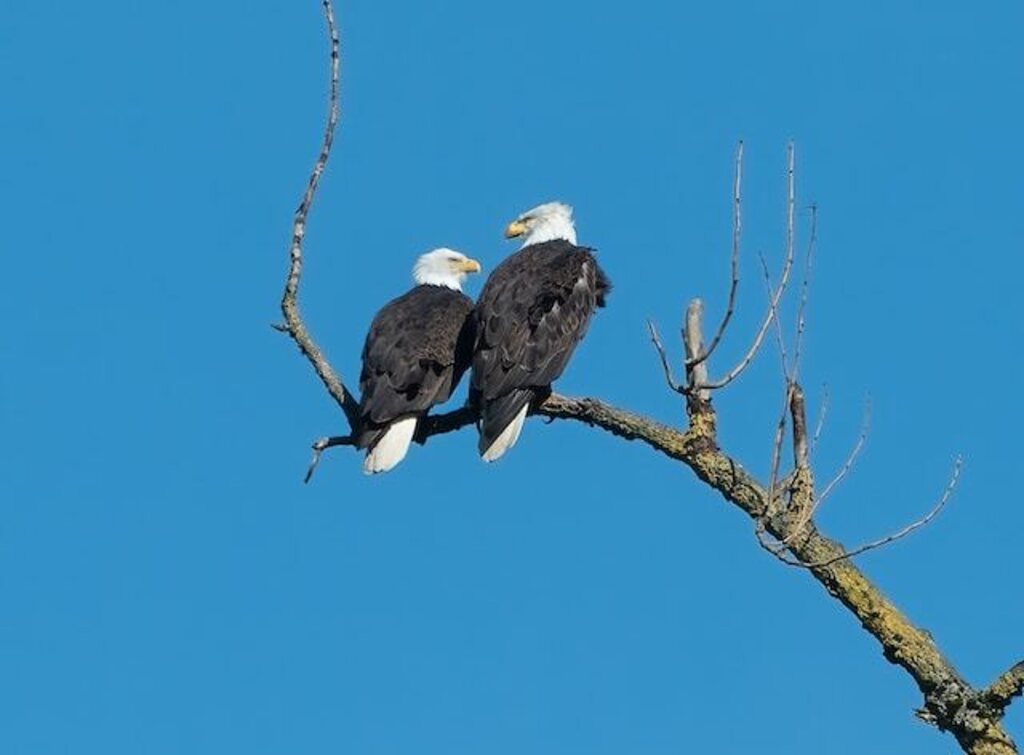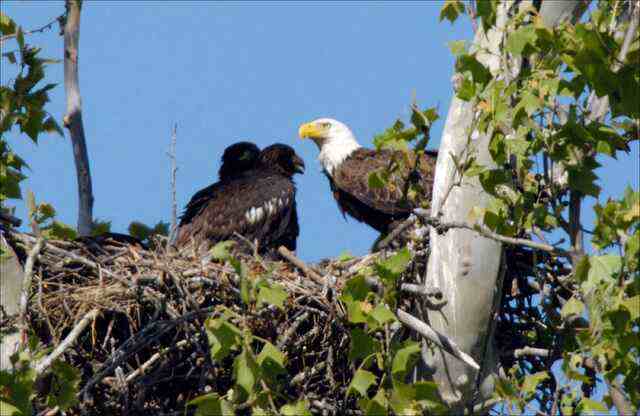Do eagles mate for life?” In this exploration of eagle behavior, we delve into whether these majestic birds truly form lifelong partnerships, revealing the intricacies of their mating rituals and the fascinating dynamics of their relationships.
Table of Contents
- 1 Definition of Eagles
- 2 Importance of Eagles in Nature
- 3 Overview of Eagle Mating Habits
- 4 Courtship Rituals of Eagles
- 5 Pair Bonding and Mate Selection Process
- 6 Nest Building
- 7 Territory Establishment
- 8 Do Eagles Mate for Life?
- 9 Benefits and Challenges of Monogamy in Eagles
- 10 Conclusion
- 11 FAQs: Do Eagles Mate For Life?
- 11.1 What are the courtship rituals of eagles?
- 11.2 How do eagle pairs build their nests?
- 11.3 How many eggs do eagles lay per nesting season?
- 11.4 Are eagles monogamous throughout their lives?
- 11.5 What is the significance of eagle mating habits in nature?
- 11.6 Do all eagle species exhibit monogamous behavior?
- 11.7 How do eagles defend their nests and territories?
- 11.8 What are the benefits of monogamy for eagles?
- 11.9 Are there any challenges associated with eagle monogamy?
- 12 Author
Definition of Eagles
Eagles are birds of prey belonging to the family Accipitridae and subfamily Buteoninae. They are easily recognized by their strong hooked beaks, large size, broad wingspan, and sharp talons that allow them to catch and kill other animals with ease.
There are over 60 species of eagles found worldwide; some common species include:
Bald eagles (Haliaeetus leucocephalus), Golden eagles (Aquila chrysaetos), African fish eagles (Haliaeetus vocifer), and Wedge-tailed eagles (Aquila audax). Eagles occupy a diverse range of habitats, from lowland forests and grasslands to mountainous regions.

Importance of Eagles in Nature
Eagles play crucial ecological roles as top predators in many ecosystems worldwide.
They help maintain ecological balance by controlling populations of other animals such as rodents and rabbits that would otherwise overgraze vegetation or cause other environmental damage.
Eagles also act as scavengers by feeding on dead animals; this helps prevent the spread of diseases by removing carcasses from the environment.
Additionally, these birds create nest sites that provide shelter for other animals such as owls or bats. Hence, the presence of eagles is critical to the overall health of many ecosystems.
Overview of Eagle Mating Habits
Eagles are monogamous birds that form long-term pair bonds with their mates. They exhibit complex courtship rituals that involve aerial displays and mutual vocalizations to attract potential partners.
Once they select a mate, they build nests together in high places such as trees or cliffs, which serve as their breeding territories and shelters for future offspring.
Eagles lay one to three eggs per nesting season, which both parents incubate and care for jointly until hatching.
After hatching, the parents continue to provide food and protection for their young until they fledge. However, some eagle species may replace their mates if one dies or fails to produce healthy offspring.
Eagles are fascinating birds with impressive physical features and ecological importance.
They form long-term pair bonds with their mates and engage in complex courtship rituals before building nests together in high places such as trees or cliffs where they can breed and raise offspring.
Despite being monogamous birds that mostly mate for life, some eagle species may replace their mates if necessary.
In the following sections of this article, we will delve deeper into this question: do eagles truly mate for life?
Courtship Rituals of Eagles
Eagles are known for their elaborate courtship rituals, which can last for weeks or even months. These rituals often involve a series of aerial displays and vocalizations that are intended to impress potential mates.
One common display is the “cartwheel” display, where the male and female eagles lock talons in mid-air and cartwheel through the sky together.
Other displays may include soaring, diving, and swooping. In addition to aerial displays, eagles also engage in ground-based displays that may involve posturing or vocalizing.
For example, the male eagle may puff up his chest feathers and bow his head while making a series of calls to attract the female’s attention.
The female eagle may respond with her own calls or by preening herself in front of the male.
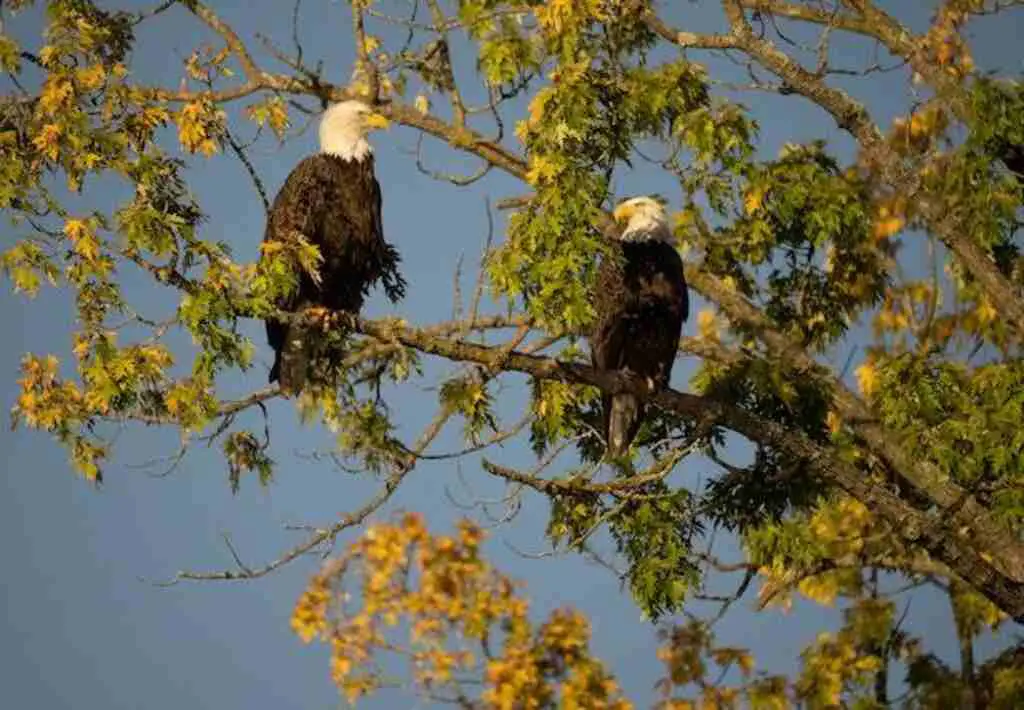
Pair Bonding and Mate Selection Process
Eagles are monogamous birds that mate for life (although there are some cases of infidelity).
The pair bonding process usually begins during the courtship period, when potential mates engage in complex social interactions to establish compatibility and ensure genetic diversity.
Once a pair has been established, they will work together to build a nest that can reach an impressive size over time.
The nest building process may take several weeks or even months as both partners bring branches, twigs, grasses and any other available materials to fortify their nest.
The choice of nesting site is also crucial for pair bonding, as eagles prefer secluded areas where they can raise their young away from predators and human disturbances.
Nest Building
Eagle nests (also known as eyries) can be found high up on trees, cliffs or other elevated locations such as utility poles.
They are typically constructed near water sources where prey is abundant. Eagles have been known to use the same nest year after year, adding new materials each year.
The nests can weigh up to 2,000 pounds and measure over six feet across.
The interior of the nest is covered with soft materials like grass, moss or fur to provide a comfortable and warm environment for the offspring.
Territory Establishment
Eagles are fiercely territorial birds that protect their nesting sites from other eagles and intruders.
The size of their territory depends on the availability of food resources, with some territories reaching over 60 square miles.
Eagles will defend their territory by vocalizing, chasing off intruders or engaging in aerial combat.
They are known to be very aggressive when it comes to protecting their young, as they are vulnerable for a long time after birth.
Eagle mating habits involve elaborate courtship rituals, pair bonding and mate selection processes, nest building and territory establishment.
These behaviors allow eagles to establish strong bonds with their partners while ensuring genetic diversity and reproductive success.
Do Eagles Mate for Life?
Explanation of Monogamy in Birds
Monogamy is a reproductive strategy that involves individuals mating with only one partner during a breeding season or for many years.
This behavior has many benefits, including increased parental care and shared territory defense.
In birds, monogamy is common among species that live in environments where resources are scarce, and territories are limited.
Monogamous pairs of birds often work together to defend their nest site from intruders and predators, which can increase the chances of reproductive success.
Evidence Supporting Eagle Monogamy
Eagle mating patterns have been extensively studied by ornithologists, who have found that most eagle species exhibit monogamous behavior.
Bald eagles, for example, mate for life and will only seek out a new mate if their current partner dies or fails to return in the breeding season.
Similarly, golden eagles typically form long-term pair bonds and will defend their nest sites from other eagles or predators.
The evidence supporting eagle monogamy comes from observations of nesting behaviors over several breeding seasons.
Researchers have found that once an eagle pair forms a bond, they will work together to build their nest and raise their young.
These pairs also engage in courtship rituals each year before laying eggs. These behaviors suggest that eagle pairs form strong social bonds with each other.
Factors That May Lead to Mate Replacement
While most eagles stay with their partners for life, there are some cases where mate replacement occurs.
One factor that may lead to mate replacement is the death of one partner during the breeding season or over the winter months when eagles migrate to warmer climates.
Another factor that may lead to mate replacement is infertility. If an eagle pair fails to produce offspring after several years of trying, they may split up and search for new mates.
Competition for resources can also lead to mate replacement. In areas where food sources are scarce, eagles may abandon their partners and search for new territories with better resources.
Overall, while eagles do exhibit monogamous behavior, there are some instances where mate replacement occurs.
However, eagle pairs that stay together for life have a higher chance of reproductive success due to increased parental care and territory defense.

Benefits and Challenges of Monogamy in Eagles
Benefits of Monogamous Relationships
Eagles are known to form monogamous relationships, which in many cases can be beneficial for the species. One of the main advantages of monogamy is an increased reproductive success rate.
This is because when a pair of eagles mate for life, they develop a strong bond that enables them to work together in raising their offspring.
When both parents are invested in the survival and well-being of their young, the chances of successful reproduction increase significantly.
Another benefit of monogamous relationships is shared parental responsibilities. Eagles typically build their nests in high trees or cliffs, making it difficult for predators to reach them.
However, this also makes it challenging for eagles to attend to their nests and young simultaneously.
With a partner, eagles can take turns guarding the nest and finding food, ensuring that their chicks have a constant supply.
In addition to enhanced reproductive success and shared parental responsibilities, monogamy also helps with territorial defense.
Because eagles often defend large areas around their nests from potential threats like other birds or predators, having two parents allows them to better cover all angles while defending against these threats.
Challenges of Monogamous Relationships
Despite its benefits, there are also some challenges associated with monogamy among eagles. Limited genetic diversity is one such challenge that can arise from staying paired with only one mate throughout life.
Inbreeding may result from repeated mating with close relatives within small populations over time.
Another major challenge associated with monogamous relationships in eagles is the risk associated with dependence on a single partner for life.
If an eagle loses its mate due to death or injury, it may have trouble finding a new partner and starting another family successfully.
Furthermore, when there’s a long-term relationship between two individuals (like in monogamous eagles), it can be challenging to find a new partner that meets the same level of compatibility as the previous one.
If a surviving eagle has difficulty finding another mate, then it may compromise its reproductive success and lead to population decline.
Because eagles exclusively pair with one another for life, there is a risk of creating non-viable offspring if pairs have genetic incompatibilities.
Genetic variation helps to ensure that offspring are healthy and able to survive in changing environments.
The benefits of monogamous relationships among eagles include increased reproductive success, shared parental responsibilities, and enhanced territorial defense.
However, there are challenges associated with it such as limited genetic diversity and dependence on a single partner for life.
By understanding both the advantages and limitations of this mating strategy, we can develop better conservation efforts aimed towards preserving these iconic birds.
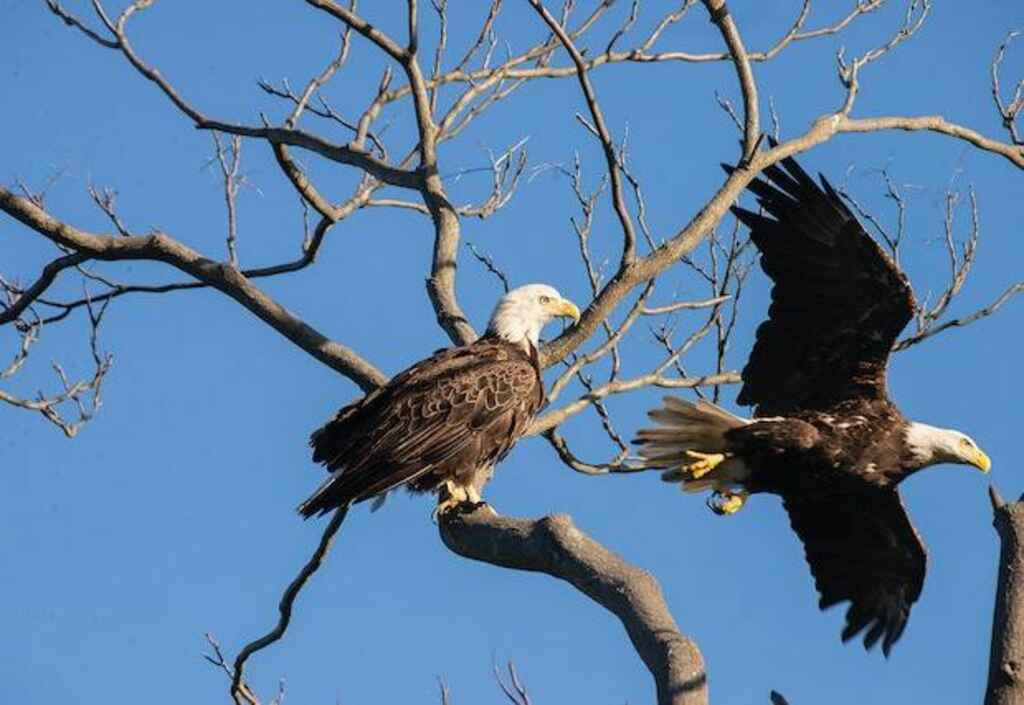
Conclusion
Summary of Key Points on Eagle Mating Habits and Monogamy
Eagles are a highly respected bird species known for their majesty, strength, and soaring abilities.
These birds use their keen hunting skills to provide for themselves and their offspring, which they raise together with their mate.
Courtship rituals are an essential component of eagle mating habits, which involve pair bonding and territory establishment.
The most remarkable feature of eagle mating habits is the monogamous nature of their relationships.
Eagles mate for life, meaning they stay with the same partner until one dies.
There is strong evidence supporting this trend, suggesting that eagles establish long-lasting bonds with a single partner for the purpose of enhancing reproductive success and parental responsibilities.
Implications for Conservation Efforts
Eagle conservation efforts are critical because these magnificent creatures face numerous threats from humans and environmental challenges such as pollution and habitat destruction.
Therefore, understanding eagle mating habits is crucial to preserving these beautiful birds in the wild.
In light of this research on eagle monogamy, conservationists can take steps to protect both adult eagles as well as their chicks by ensuring that nesting areas remain undisturbed during breeding seasons.
Additionally, programs can be put in place to provide better protection against poaching or other human activities that may endanger eagles’ lives.
Future Research Directions
There is still much we don’t know about eagle mating habits and monogamy, which opens up many possibilities for future research studies.
For instance, research could investigate more deeply into why some eagles break up with their mates even though they have a high degree of pair bonding.
Additionally, future work could explore how environmental factors such as food availability or weather conditions influence courtship rituals or nest building behaviors among different populations or species of eagles across different regions around the world.
Ultimately, these research findings and conservation efforts are essential to ensuring that future generations can continue to benefit from having the opportunity to see these captivating and awe-inspiring creatures in their natural habitats.
By protecting eagles and learning more about their mating habits, we can strengthen our understanding of nature and our role in maintaining it.
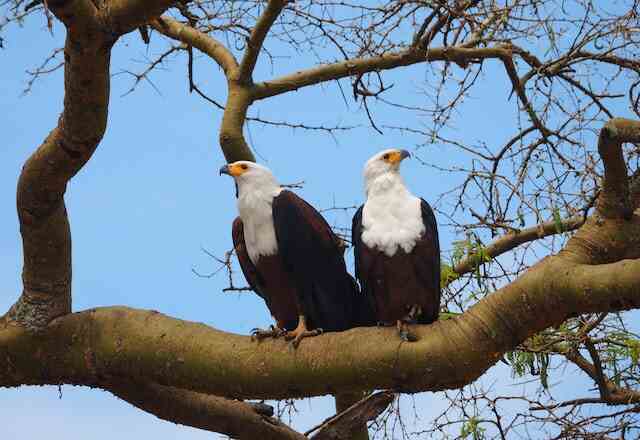
FAQs: Do Eagles Mate For Life?
What are the courtship rituals of eagles?
Eagles engage in elaborate courtship rituals, including aerial displays, mutual vocalizations, and ground-based displays. These rituals play a crucial role in attracting potential mates.
How do eagle pairs build their nests?
Eagle pairs work together to build nests in high places like trees or cliffs. They gather materials such as branches, twigs, and grass to construct and fortify their nests, which can reach impressive sizes over time.
How many eggs do eagles lay per nesting season?
Eagles typically lay one to three eggs per nesting season. Both parents take part in incubating the eggs and caring for the young until they hatch and eventually fledge.
Are eagles monogamous throughout their lives?
Yes, eagles are generally monogamous birds that mate for life. However, in certain cases, such as the death of a partner or failed reproduction, mate replacement can occur.
What is the significance of eagle mating habits in nature?
Eagle mating habits play a crucial role in maintaining ecological balance. By controlling populations of prey species and scavenging on carcasses, eagles contribute to the overall health of ecosystems.
Do all eagle species exhibit monogamous behavior?
Most eagle species exhibit monogamous behavior, forming long-term pair bonds. However, there may be variations in mating habits among different species and populations.
How do eagles defend their nests and territories?
Eagles are fiercely territorial birds. They use vocalizations, aerial combat, and aggressive behavior to defend their nests from intruders, ensuring the safety of their young.
What are the benefits of monogamy for eagles?
Monogamy among eagles offers several advantages, including increased reproductive success, shared parental responsibilities, and enhanced territorial defense against potential threats.
Are there any challenges associated with eagle monogamy?
While monogamy benefits eagles, it can also present challenges, such as limited genetic diversity and dependence on a single partner. Factors like death, infertility, or competition for resources may lead to mate replacement.

